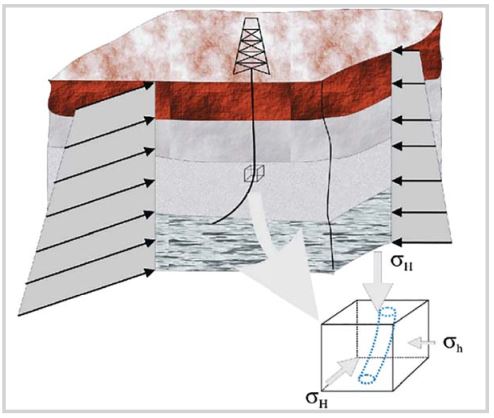Software development for stress state analysis around wellbore applied in geomechanical model
Abstract
This paper presents the results of analysing the stress state changes during the drilling process on the basis of data assumptions and analysis of some influential effects of input parameters on the analysis results. Based on theoretical foundations and analytical solutions of stress state equation, named “Kirsch equation”, for the case of wells drilled in rock and with the assumption that the material is elastic, linear and homogeneous, the authors have developed a “W3IPVU” calculation programme using specialised programming language (open source, runs on Linux) which allows analysis of the changes of stress state in any well trajectory given. The reservoir applied to this programme follows the Kirsch hypothesis. The initial results as presented in this paper show the change of the stress field while drilling, which mostly depends on the drilling direction. The increment in tangential stress may be affected by drilling and dependent on the well diameter.
References
2. R.T.Ewy. Wellbore - Stability predictions by use of a modif ed lade criterion. SPE Drilling & Completion. 1999; 14(2): p. 85 - 91.
3. A.M.AI-Ajmi, R.W.Zimmerman. Stability analysis of vertical boreholes using the Mogi-Coulomb failure criterion. International Journal of Rock Mechanics and Mining Science. 2006; 43(8): p. 1200 - 1211.
4. Xiaorong Li, K.E.Gray. Wellbore stability of deviated wells in depletion reservoir. SPE-174860-MS. SPE Annual Technical Conference and Exhibition, Houston, Texas, USA 28 - 30 September, 2015.
5. Junliang Yuan, Jingen Deng, Yong Luo, Shisheng Guo, Haishan Zhang, Qiang Tan, Kai Zhao, Lianbo Hu. The research on borehole stability in depleted reservoir and caprock: using the geophysics logging data. The Scientifc World Journal. 2013.
6. M.R.McLean, M.A.Addis. Wellbore stability: the effect of strength criteria on mud weight recommendations. SPE Annual Technical Conference and Exhibition, New Orlean, USA. 23 - 26 September, 1990.
7. Borivoje Pašić, Nediljka Gaurina-Međimurec, Matanović Davorin. Wellbore instability: causes and consequences. The Mining Geological Petroleum Engineering Bulletin. 2007; 19(1): p. 87 - 98.
8. Fanhong Meng, Giin Fa Fuh. Reservoir depletion effect on in situ stresses and mud weight selection. 44th U.S - Canada Rock Mechanics Symposium and 5th U.S – Canada Rock Mechanics Symposium, Salt Lake city, Utah. 27 – 30 June, 2010.
9. Jincai Zhang. Borehole stability analysis accounting for anisotropies in drilling to weak bedding planes. International Journal of Rock Mechanics and Mining Sciences. 2013; 60: p. 160 - 170.
10. M.King Hubbert, David G.Willis. Mechanics of hydraulic fracturing. Society of Petroleum Engineers. 1957;210: p. 153 - 168.
11. R.P.Steiger, P.K.Leung. Lecture: Predictions of wellbore stability in shale formations at great depth. International Society for Rock Mechanics. 1989.
12. X.Chen, C.P.Tan, C.M.Haberfeld. Guidelines for efcient wellbore stability analysis. International Journal of Rock Mechanics and Mining Sciences. 1997; 34(3 - 4): p. 50.e1 - 50.e14.
13. S.Li, Cary C.Purdy. Maximum horizontal stress and wellbore stability while drilling: modelling and case study. SPE Latin American and Caribbean Petroleum Engineering Conference, Lima, Peru. 1 - 3 December, 2010.
14. Adel Al-Ajmi. Wellbore stability analysis based on a new true-triaxial failure criterion. Thesis, KTH Land and Water Resources Engineering. 2006.
15. Bernt S.Aadnoy, Reza Looyeh. Petroleum rock mechanics: Drilling operations and well design. Gulf Professional Publishing. 2011.
16. Mark D.Zoback. Reservoir geomechanics. Cambridge University Press, New York. 2007.
17. J.B.Cheatham Jr. Wellbore stability. Journal of Petroleum Technology. 1984; 36(6); p. 889 - 896.
18. Erling Fjaer, R.M.Holt, A.M.Raaen, R.Risnes, P.Horsrud. Petroleum related rock mechanics (2nd edition). Elsevier Science. 2008.
19. Nguyen The Duc, Phan Ngoc Trung, Nguyen Minh Quy. Wellbore stability analysis for predicting sand production. International Symposium Hanoi Geoengineering 2013, Vietnam. 22 - 23 November, 2010.
20. Liangyang Zhang, Ping Cao, K.C.Radha. Evaluation of rock strength criteria for wellbore stability analysis. International Journal of Rock Mechanics and Mining Sciences. 2010; 47(8): p. 1304 - 1316.
21. Tạ Quốc Dũng, Phạm Trí Dũng, Nguyễn Văn Thuận. Xây dựng mô hình địa cơ học ứng dụng trong phân tích ổn định thành giếng khoan nghiêng Oligocence hạ - bồn trũng Cửu Long. Hội nghị Khoa học Công nghệ lần thứ 14, Đại học Bách Khoa Tp. Hồ Chí Minh. 29/10 - 1/11/2015.
22. Tạ Quốc Dũng, Phạm Minh Khánh, Hồ Hoàng Phúc, Nguyễn Bình Phương. Ứng dụng các tiêu chuẩn phá hủy trong xác định áp suất gây sập lở thành giếng khoan trong phân tích ổn định thành giếng khoan. Hội nghị Khoa học Công nghệ lần thứ 14, Đại học Bách Khoa Tp. Hồ Chí Minh. 29/10 - 1/11/2015.

1. The Author assigns all copyright in and to the article (the Work) to the Petrovietnam Journal, including the right to publish, republish, transmit, sell and distribute the Work in whole or in part in electronic and print editions of the Journal, in all media of expression now known or later developed.
2. By this assignment of copyright to the Petrovietnam Journal, reproduction, posting, transmission, distribution or other use of the Work in whole or in part in any medium by the Author requires a full citation to the Journal, suitable in form and content as follows: title of article, authors’ names, journal title, volume, issue, year, copyright owner as specified in the Journal, DOI number. Links to the final article published on the website of the Journal are encouraged.




